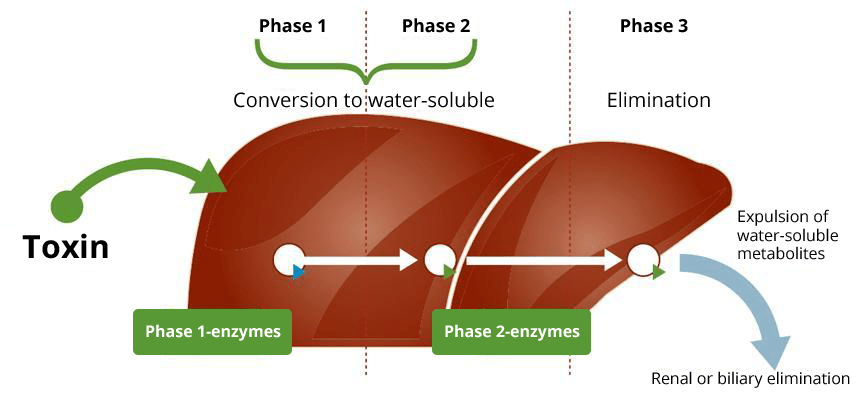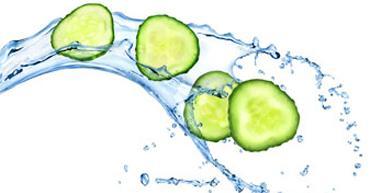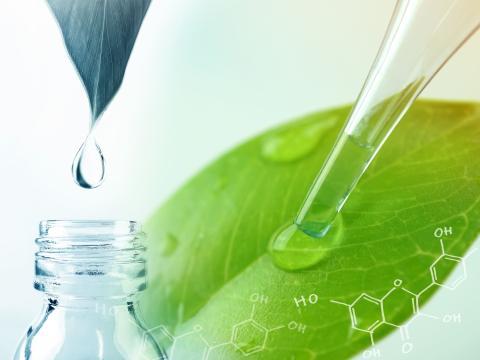In what circumstances is detox needed, and why?
Chronic fatigue, bad breath, nausea, pale skin... Various different symptoms are tell-tale signs of the need for hepatic detoxification.
Because every individual is different, there are many reasons why the ability of the liver to detox the body can be overloaded. Smoking, alcohol and/or medication impair the liver’s natural detoxification abilities, as can concurrent inflammation or infection. Digestive disorders and genetic polymorphism can also create circumstances in which the liver is overloaded.
In his book “The secrets of micronutrition” (available in French only), Dr B. Guérineau defines detoxification as a “natural process that protects our functions and involves eliminating harmful toxins from cells and tissues so that normal functioning can be restored.”.
These toxins, also called xenobiotics, are primarily eliminated by the liver, but also via the intestines, gallbladder, kidneys, lungs and skin.
Xenobiotics are compounds that are potentially toxic and foreign to the body. They are present in the environment as pesticides and can also be ingested when they are ingredients of medicinal products, notably antibiotics.
So that they can be eliminated correctly by the body, fat-soluble xenobiotics must become water-soluble. The liver plays a key role in this transformation since its cells (hepatocytes) contain the necessary enzymes.

The hepatic detoxification process comprises three successive phases:
- P450 cytochrome enzymes neutralise certain toxins which can be eliminated directly. The other toxins are converted into an intermediate form.
- The purification of the transformed toxins produces free radicals, which can be themselves neutralised if the intake of antioxidants is correct (glutathion is the most important antioxidant in the liver)
- Once in a water-soluble form, the transformed compounds can be evacuated by active transporters. This elimination occurs primarily via the kidneys, with the compounds expelled in the urine. Depending on the nature of the compounds, some will also be expelled via the bile (as stools), exhaled or eliminated as sweat.
How to enhance detoxification levels
There are several foods and behaviours which can improve the functionalities of the liver.
Water
Drinking at least 1.5 litres of water every day ensures that the kidneys work effectively and facilitates elimination. In addition to spring water, drunk cold or as an infusion, it is a good idea to favour diuretic foods such as cucumber, melon, endives (chicory) or lettuce.

Detox foods
So that the enzymes in the liver can function effectively and transform and evacuate toxins from the body, you should favour organic food rich in glucosinolates. Rapeseed, white mustard, the various types of cabbage and radish have a high glucosinolate content. Glucosinolates are responsible for the bitter or sharp flavour of these foods and play a role in detoxification by stimulating certain enzymes.
|
Average glucosinolate content |
Content (mg/g) |
|---|---|
| Brussels sprouts | 1,50 - 2 |
| Cauliflower | 0,50 |
| Broccoli | 0,70 |
| Turnip | 0,2 - 0,6 |
| Swede | 0,2 - 5,6 |
| Rapeseed | 21,8 - 51,6 |
| White mustard | 61,1 |
| Radish | 0,4 - 21,8 |
| Red cabbage | 0,1 - 1,2 |
| White cabbage | 0,08 - 1 |
Detox plants
The liver is thus an essential organ in terms of the functioning of the body.
Using plants is an excellent way to help the liver perform its physiological functions, particularly when it is overloaded.
The plants to be used can be selected based on the specific action required:
- rosemary, artichoke and black radish detoxify the liver and accelerate drainage,
- desmodium protects the liver,
- Scotch thistle stimulates and regenerates it.
Behaviours
Adopting a healthy lifestyle is the best way to help your body detox: eat simply and naturally, consume nothing to excess (particularly saturated fats and alcohol), and take up a sport or activity that increases your exercise levels.
Limit your exposure to xenobiotics
To restrict, as much as possible, your contact with toxins, it is a good idea to be aware of the sources of these pollutants so that you can steer away from them. When outdoors, try to walk when you can, avoiding busy roads as much as possible. When inside, ventilating rooms for at least ten minutes a day limits your exposure. Also, ensure that gas heaters of all types are maintained to reduce your potential exposure to carbon monoxide. It is also advisable to avoid cleaning products packed with chemical products.
If you have symptoms or would like more information about detoxification, you are advised to consult a doctor. A specialist may recommend a detoxification programme tailored to your individual requirements.






